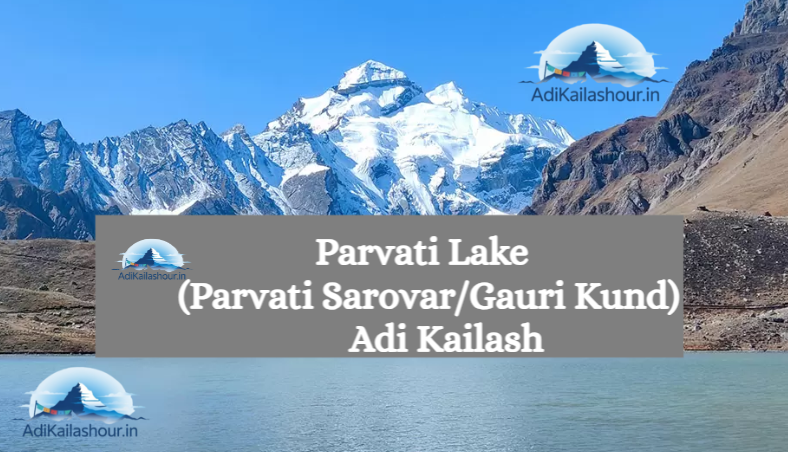Nestled at the foot of the revered Adi Kailash peak in the remote Kumaon Himalayas of Uttarakhand, Parvati Lake is a crystal-clear, high-altitude glacial lake that holds immense spiritual significance for pilgrims. Often referred to as Parvati Sarovar or Gauri Kund, it is an integral part of the Adi Kailash Yatra, embodying purity, devotion, and divine presence.
Location and Elevation
Parvati Lake is situated at an elevation of approximately 4,497 meters (14,754 feet) above sea level. It is located near Jolingkong, which serves as the base camp for Adi Kailash darshan. From the motorable roadhead at Jolingkong, pilgrims undertake a relatively short trek to reach the serene shores of the lake.
- Proximity to Adi Kailash: The lake lies directly at the base of the majestic Adi Kailash mountain, offering a breathtaking reflection of the peak on its clear waters on a cloudless day.
- Accessibility: After reaching Jolingkong by specialized 4×4 vehicles (from Dharchula via Gunji), there is a trek of about 1 to 3 kilometers to reach Parvati Lake. This final stretch is typically a gentle walk, making it accessible for most pilgrims who have already acclimatized to the altitude.
Spiritual and Mythological Significance
Parvati Lake is steeped in Hindu mythology, primarily associated with Goddess Parvati, the consort of Lord Shiva.
- Abode of Parvati: Legend has it that Goddess Parvati used to bathe in these pristine waters. Some traditions also suggest that she meditated here to attain Lord Shiva, and that the divine couple, along with their son Ganesha, resides in this sacred region.
- Symbol of Purity: The lake’s clear, still waters are believed to possess purifying qualities. Devotees consider taking a holy dip (or at least sprinkling the water on themselves) to be an act of immense spiritual merit, capable of cleansing sins and granting inner peace.
- Manasarovar of Adi Kailash: Due to its profound sacredness and its association with Adi Kailash (often called “Chhota Kailash” or “Little Kailash” as a replica of Mount Kailash), Parvati Lake is sometimes referred to as the “Manasarovar of Adi Kailash,” drawing parallels to the larger, highly revered Mansarovar Lake near Mount Kailash in Tibet.
- Divine Blessings: Pilgrims visit the lake to seek blessings for marital bliss, harmony, and spiritual growth, believing that the divine energy of Shiva and Parvati permeates this holy site.
Physical Characteristics and Natural Beauty
Beyond its spiritual aura, Parvati Lake is a pristine natural marvel that captivates visitors with its tranquil beauty.
- Crystal-Clear Waters: The lake is known for its exceptionally clear and calm waters, which create a stunning mirror-like effect, reflecting the towering Adi Kailash peak and the surrounding Himalayan landscape.
- Surrounding Landscape: The lake is encircled by dramatic snow-capped peaks, alpine meadows, and a raw, untouched natural environment. The silence and remoteness of the location contribute to a profound sense of peace and contemplation.
- Seasonal Changes: Parvati Lake remains frozen for a significant part of the year, particularly during the winter months. In late spring and summer, as the snow melts, it transforms into a vibrant blue or emerald-green water body, framed by blooming wildflowers.
Rituals and Activities at Parvati Lake
For pilgrims, visiting Parvati Lake is a deeply spiritual experience.
- Holy Dip/Sprinkling: Many devotees take a holy dip in the lake, or at least sprinkle its sacred water on themselves, as a ritual of purification and devotion.
- Prayers and Offerings: At the shoreline of Parvati Lake, there is often a small shrine or a designated area for prayer, sometimes housing idols of Lord Shiva and Goddess Parvati. Pilgrims offer prayers, chant mantras, and sometimes leave small offerings.
- Meditation and Reflection: The serene and powerful atmosphere of the lake makes it an ideal spot for meditation and quiet introspection, allowing pilgrims to deepen their spiritual connection.
- Darshan of Adi Kailash: The lake provides one of the most magnificent viewpoints for a clear darshan (sight) of the Adi Kailash peak, which stands majestically in the background.
Visiting Parvati Lake
Accessing Parvati Lake is part of the larger Adi Kailash Yatra, which typically requires an Inner Line Permit (ILP) and an organized tour due to the challenging terrain and remote location. The best time to visit is during the yatra season, from May to June and September to early November, when the lake is accessible and the weather is relatively favorable.
A visit to Parvati Lake is not just a geographical destination; it’s a journey into faith, offering a rare opportunity to connect with the divine amidst the awe-inspiring grandeur of the Himalayas.

